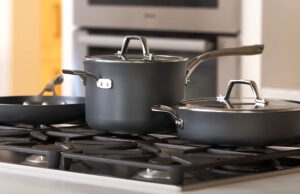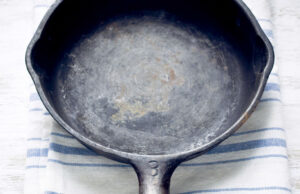As an Amazon Associate, I earn from qualifying purchases at no extra cost to you.
Can You Put Metal in a Microwave? The Truth You Need to Know
Hey, have you ever wondered if it’s safe to toss a spoon or foil into the microwave? Maybe you’ve heard horror stories about sparks flying or the microwave catching fire. But is that just an exaggeration, or is there some truth behind it? Well, I’m here to clear things up. You’re probably curious if it’s okay to put metal in the microwave, and what exactly happens when you do. Trust me, it’s not as simple as you might think, but I’ve got all the answers you need to avoid a microwave disaster. Let’s dive into this topic and figure out whether you should keep that metal away or if it’s safe to experiment.

Can You Put Metal in a Microwave? Here’s What You Need to Know
You’ve probably heard mixed opinions about putting metal in a microwave. Some say it’s a big no-no, while others claim they’ve done it with no issues. But the real question is, why does metal behave so strangely when heated in a microwave? To understand this better, let’s first take a look at how microwaves work.
How Microwaves Heat Your Food
Before we jump into the metal drama, let’s first understand how a microwave works. Microwaves heat food using electromagnetic waves that cause water molecules in the food to vibrate, producing heat. This is how your frozen pizza becomes hot and delicious in minutes. However, the way these waves interact with different materials plays a huge role in whether it’s safe to microwave something.
Why Metal Doesn’t Like Microwaves
Now, here’s where metal comes into the equation. Metals are good conductors of electricity, meaning they can interact with electromagnetic waves in unique ways. When microwaves hit metal, they cause electric currents to flow across the metal surface. This can create sparks, which could potentially start a fire. And if you’re using thin foil or something sharp, those sparks can become even more dangerous.
But, don’t worry just yet! It’s not always as scary as it sounds. There are exceptions, and I’ll go over when it’s okay to use metal in your microwave, so you won’t have to toss your microwave-friendly metal containers just yet.
The Dangers of Microwaving Metal: Myths vs. Facts
Now, let’s separate the myths from the facts when it comes to microwaving metal. You’ve probably heard plenty of tall tales about metal in the microwave, but what’s true and what’s just panic-induced gossip? Here’s a breakdown:
The Spark Show: Is It Really That Dangerous?
One of the biggest fears people have when it comes to microwaving metal is the possibility of sparks. Yes, it’s true that metal can cause sparks when microwaved, but that doesn’t mean every piece of metal is a fire hazard. Sparking happens when the metal has sharp edges, like the edges of foil or a fork. These edges concentrate the microwaves in a way that causes the air around the metal to ionize, resulting in visible sparks. This is especially true for aluminum foil.
But, are sparks always dangerous? In most cases, sparking just leads to a harmless show of flashing lights, though it can damage your microwave. But, don’t let that deter you; you’ll want to avoid it for safety reasons. So while it’s not always a catastrophe, the sparks can still cause some damage, so it’s best to keep metal out unless you know what you’re doing.
Can Metal Cause Fires?
It’s easy to think that metal in the microwave will instantly cause a fire, but that’s not always the case. For a fire to happen, you would need a few things: a lot of heat buildup and enough sparks to ignite the surrounding air or food. The chances of this happening with a small piece of metal are low, but still possible if you use the wrong materials or don’t pay attention.
Aluminum foil is notorious for catching fire if not used carefully. The problem with foil is that it can heat up super quickly, and if it’s too crinkled or thin, it can cause a fire hazard. So, while it’s not likely that your microwave will catch fire every time you microwave metal, it’s always better to err on the side of caution.
What Happens if You Microwave a Metal Bowl or Cup?
Using a metal bowl or cup in the microwave is a common mistake. As we’ve established, metals can interact with microwaves in unpredictable ways. Depending on the type of metal and the shape of the container, the microwaves may bounce off the metal in ways that can lead to sparks or uneven heating.
Some metal containers, especially those with rounded edges or thick sides, can cause microwaves to bounce around inside the oven. This can create uneven heating, leading to hot spots in your food or even damage to your microwave. But if the metal is smooth and there’s no sharp edge or crinkle, the risks are reduced.
Can You Use Metal to Cover Food?
One of the safest ways to use metal in the microwave is by covering food with a microwave-safe lid or plate made of metal. The key is to make sure the metal does not touch the walls of the microwave or any other metal objects. By covering food with metal, you can help prevent splattering and ensure the heat is distributed evenly.
For example, using a microwave-safe metal cover for dishes like casseroles or leftovers is fine as long as it doesn’t come into direct contact with the microwave’s sides. Always check for the label that confirms it’s microwave-safe, as some metal covers are designed specifically for this purpose.
How to Safely Use Metal in a Microwave: Best Practices
Okay, so you’ve got the lowdown on the dangers, but what about the safe ways to use metal in your microwave? Don’t worry; I’ve got you covered. Here are some tips to help you microwave metal safely:
Use the Right Kind of Metal
Not all metals are the same when it comes to microwaving. Some metals, like aluminum foil, can heat up quickly and cause problems, while others, like stainless steel, are a bit more forgiving. The key is knowing the type of metal you’re dealing with and understanding how it behaves when microwaved.
Aluminum foil can be used safely in certain situations, but it should always be smooth, not crinkled, and it should never touch the sides of the microwave. For other metals like stainless steel, it’s best to avoid using them altogether. If you’re unsure, always check the manufacturer’s guidelines to see if your metal containers are microwave-safe.
Avoid Sharp Edges and Small Pieces of Metal
If you’re going to use metal, make sure it’s free of sharp edges or small pieces. As we’ve learned, sharp metal edges can cause sparks, so it’s best to use smooth, solid metal pieces. For instance, metal trays with smooth, rounded edges are much safer than forks or crumpled foil.
Never Use Metal for Long Periods
If you’re microwaving something that contains metal, try to keep the time as short as possible. Microwaving for extended periods of time increases the risk of overheating the metal and causing damage or sparking. Always keep an eye on the microwave and stop it if you notice anything unusual.
Microwave-Safe Metal Containers
Some containers are specifically labeled as microwave-safe and can be used without worry. Look for containers made of stainless steel or metal with a microwave-safe coating. These are typically designed to withstand microwave heating while still providing the benefits of using metal.
I hope this clears up all the confusion about microwaving metal! Whether you decide to avoid it altogether or take a more cautious approach, always be mindful of the potential risks. You don’t want to risk damage to your microwave or, worse, a fire! So, next time you’re tempted to microwave something metal, remember these guidelines and play it safe.
Frequently Asked Questions
Is it safe to microwave a fork?
No, it’s not safe to microwave a fork or any other metal utensils. The sharp edges can cause sparks and damage to your microwave. Always use microwave-safe containers and utensils.
Can I microwave aluminum foil?
Yes, but only in small, smooth amounts and never let it touch the sides of the microwave. Crinkled or torn foil can cause sparks and a fire hazard.
Do I need to avoid all metal in the microwave?
Not all metal should be avoided, but you must be cautious. Only use metal containers or covers that are specifically labeled as microwave-safe.
Can I microwave a metal spoon in a bowl?
It’s not a good idea to microwave a metal spoon in a bowl, as it can cause sparking. Always remove any metal utensils before microwaving.
Is it dangerous to microwave food in a metal container?
It can be dangerous if the metal container has sharp edges or if it’s not microwave-safe. Always check the labels for safety.
Can microwaving metal cause a fire?
While it’s unlikely, it’s possible if the metal gets too hot or causes a spark. Always use metal carefully and follow the guidelines for safety.
Do I need to worry about microwaving food in a metal cup?
Metal cups can be problematic in the microwave. Avoid using them unless they are specifically labeled as microwave-safe.
Is it safe to use a metal tray in a microwave?
It can be safe to use a metal tray if it is microwave-safe and doesn’t have sharp edges. Always follow the manufacturer’s recommendations for use.



